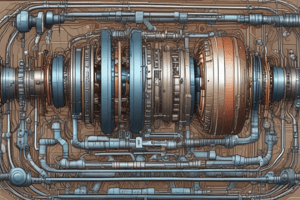Podcast
Questions and Answers
What type of force field surrounds any electrically charged body or current-carrying wire?
What type of force field surrounds any electrically charged body or current-carrying wire?
- Mechanical fields
- Chemical fields
- Electric fields (correct)
- Gravity fields
In a solenoid, where is the magnetic field strongest?
In a solenoid, where is the magnetic field strongest?
- In the center of the coil
- Outside the coil
- At the ends of the coil
- Along its axis (correct)
What happens to the magnetic field around a coil when an electric current flows through it?
What happens to the magnetic field around a coil when an electric current flows through it?
- It moves to the center of the coil
- It is generated around the coil (correct)
- It disappears
- It becomes weaker
What happens when an external magnetic field interacts with a solenoid?
What happens when an external magnetic field interacts with a solenoid?
How does a solenoid convert electrical energy into mechanical force?
How does a solenoid convert electrical energy into mechanical force?
What factor influences the strength of the magnetic field around a solenoid?
What factor influences the strength of the magnetic field around a solenoid?
Which formula defines the force generated by the interaction between current-carrying wires and external magnetic fields?
Which formula defines the force generated by the interaction between current-carrying wires and external magnetic fields?
What is the main function of a solenoid in a mechanical system?
What is the main function of a solenoid in a mechanical system?
In which application could you commonly find solenoids?
In which application could you commonly find solenoids?
How does a solenoid act as an actuator?
How does a solenoid act as an actuator?
What effect does an external magnetic field have on a solenoid?
What effect does an external magnetic field have on a solenoid?
Why are solenoids considered versatile devices in modern technology?
Why are solenoids considered versatile devices in modern technology?
Flashcards are hidden until you start studying
Study Notes
Solenoids: Harnessing Magnetic Forces
Solenoids are a fascinating blend of electromagnetism and mechanical engineering that have found their way into countless applications. To understand solenoids, let's delve into the concept of electromagnetic fields and how they power this versatile device.
Solenoids: The Basics
A solenoid is a device consisting of a coil of wire wound around a cylindrical core. When a current passes through the coil, it generates a magnetic field. When an external magnetic field or a second solenoid is applied to the first solenoid, the magnetic fields interact, allowing the solenoid to convert electrical energy into mechanical force, or vice versa.
Electromagnetic Fields
The electromagnetic field, or EM field, is an invisible force field that surrounds any electrically charged body or current-carrying wire. This field is divided into electric fields, which arise from the presence or motion of electric charges, and magnetic fields, which result from the motion of electric charges or the presence of magnetic materials.
Magnetic Fields and Solenoids
The magnetic field around a solenoid is strongest along its axis, and it is approximately uniform over a length of the solenoid. When a current flows through the coil, a magnetic field is generated around the coil. The strength of this field increases with the current and the number of turns in the coil.
The Solenoid's Mechanical Effects
A solenoid's magnetic field can be used to create mechanical force. When an external magnetic field is applied to a solenoid, it interacts with the solenoid's magnetic field, creating a mechanical force. This force can be used to move a plunger, piston, or other mechanical components within the solenoid.
Similarly, when the solenoid is used as an actuator, a mechanical force can be used to change the current flowing through the coil, in turn changing the magnetic field and moving the plunger or piston.
Lorentz Force
The mechanical force in solenoids is generated due to the Lorentz force, an interaction between current-carrying wires and external magnetic fields. This force is given by the formula:
[F = I \times B]
where (F) is the force, (I) is the current, and (B) is the magnetic field.
Applications of Solenoids
Solenoids are ubiquitous in modern technology. They can be found in a wide variety of applications, including:
- Relays
- Valves
- Motors
- Sensors
- Switches
- Actuators
In these applications, solenoids convert electrical energy into mechanical force, or vice versa, making them highly versatile devices.
Conclusion
Solenoids are a remarkable example of how electromagnetism can be harnessed to create mechanical force. They're found in countless applications, and their use continues to grow as technology advances. With their dependable mechanical effects, solenoids are set to remain a cornerstone of modern engineering for the foreseeable future.
Studying That Suits You
Use AI to generate personalized quizzes and flashcards to suit your learning preferences.




